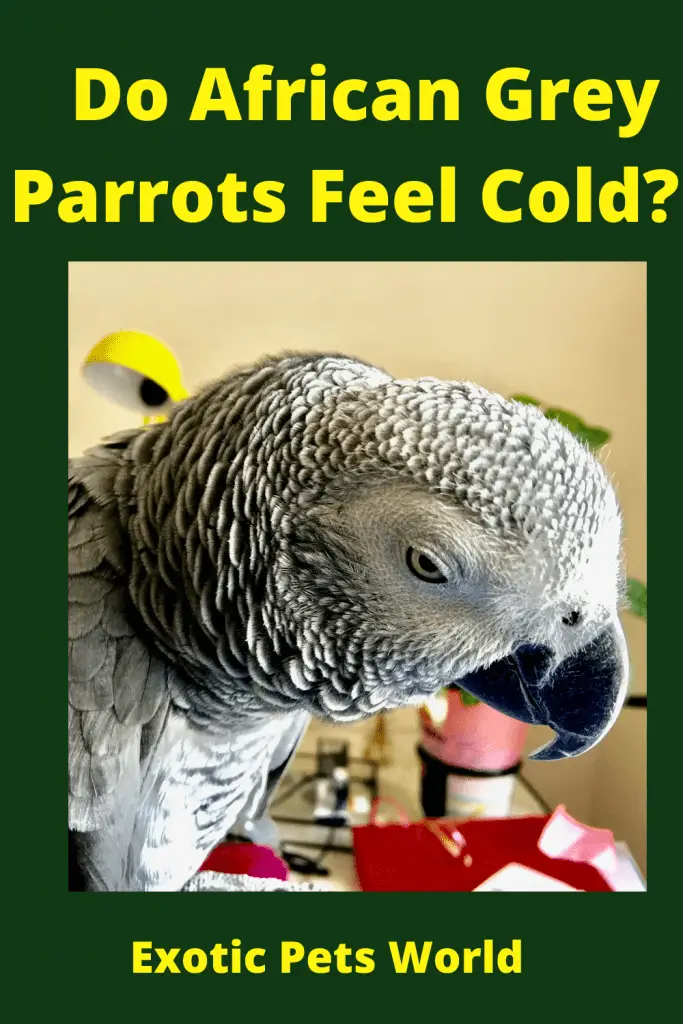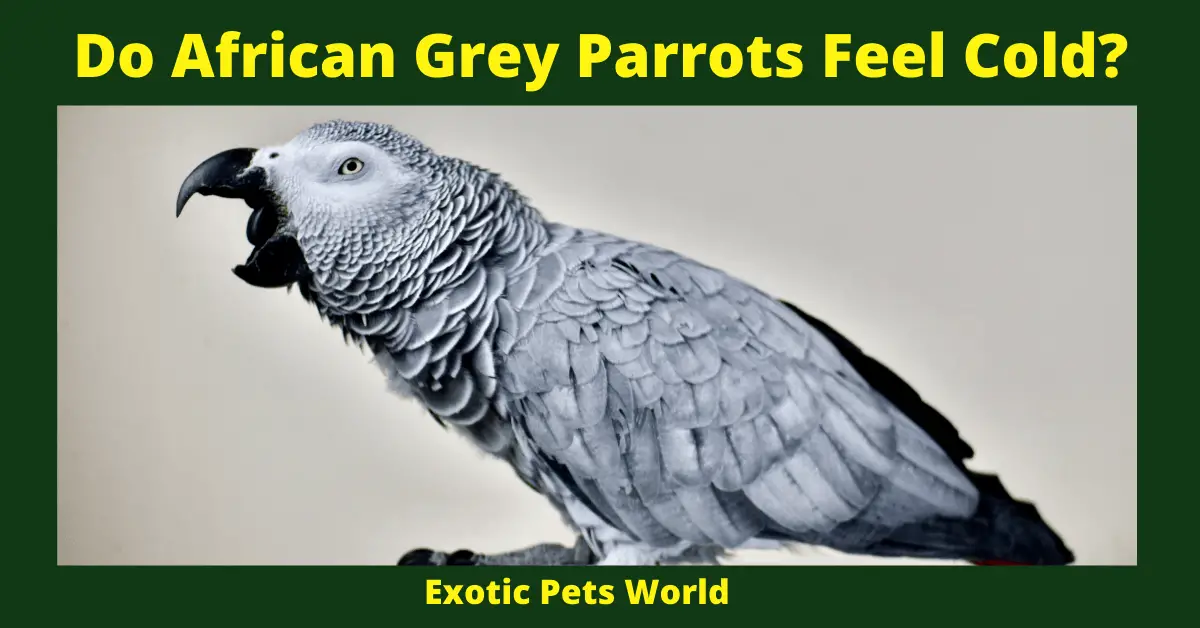Do African Grey Parrots Feel Cold
Yes, they feel cold at a cool temperature. African grey parrots are warm-blooded animals which means that they can’t regulate their body temperature according to the environment like amphibians.
Classification of African Grey
- Origin: Western and Central Africa
- Habitat: Adjacent Open Fields & Lowland Forests
- Average Size: 11-14 inches
- Lifespan: 46-65 years
Introduction:
The African Grey Parrot s is one of the most popular selling parrot species in the pet trade for a good reason. They are brilliant birds with a subtle beauty – scalloped grey feathers and a bright red or maroon tail. African Greys are famous for mimicking a variety of sounds, including human speech, to perfection.
The bond they form with their life partner and human owner is of complete devotion and trust. However, A parrot is not suitable for every home or residential situation.

The question any potential owner should ask is -Are you ready to own African Gray? Do you have space, time, and resources to make this wonderful bird a part of your family?
Scientific studies show that some of these animals react emotionally and have a mental capacity for a two-year-old human child. Many African Grey parrots will learn their owners’ words after years of practice and interaction with their ‘owners’.
Thus, they need more attention and motivation to be happy, and they behave way better than some other types of parrots.
African Grey Speciesto Sub / Types
Greys fall into two subtypes.
- Congo (Psittacus erithacus Erithacus)
- Timneh (Psittacus erithacus timneh)
These both subspecies need the same care and shelter, although a Timneh can live in a slightly smaller cage than the Congo. Congo is usually 12-14 inches long as compared to Timneh and has a bright red tail. Timnehs are generally 10 inches long with a maroon tail. Congo and Timnehs can both speak well, although some owners believe that Congo is better at mimicking the right sounds.
Timneh can talk at a young age and are generally more willing to speak in front of strangers. Congos are also more nervous and more negatively affected by changes in their daily routines than Timnehs. Still, each bird has its personality and will react differently to new situations
Do Birds Feel Cold?
Yes, birds feel cold, but they are creatures that adapt to their surroundings and stay warm in harsh conditions. Thankfully, their feathers offer some insulation, and the oil coating makes them waterproof, But for birds, nothing is worse than being cold and wet.
Do Birds Feel Cold on Their Feet?
Birds’ feet have a great adaptation that keeps them from cooling.
African Grey Parrots have a delicate, netlike pattern of arteries that interweaves blood from an African Grey’s heart with the veins carrying cold blood from its legs and feet. This system cools the blood, so the little blood that goes down to the legs/feet is already cold, so the African Grey doesn’t lose much heat.
The small amount that goes to the legs is likely just enough to keep the bird’s legs from cooling.

What Temperature do African Grey Parrots Like?
According to all avian veterinarians, the ideal temperature for African Grey Parrots is between 18 to 22 degrees Celsius. However, these parrots can withstand anything up to 29-30 degrees.
Anything under 39.2 F degrees has a very chilling effect and might be harmful to your bird. African Grey Parrots might experience heat stress above 86 degrees F.
All the parrots benefit from steady temperatures, so it’s good to ensure the optimal temperature is maintained in your home all the time (day and night). In general, all the parrots like slightly warmer temperatures.
Should I Cover my African Grey at Night?
As long as a quiet, dark, and somewhat secluded area is provided for an African Grey to sleep in, most of them will be fine without being covered at night. Remember, sleep is vital to an African Grey’s good health and well-being. If you doubt your pet bird’s reaction to being uncovered, play it safe and resume covering the cage at night.
African Grey Housing
African grey parrots are medium to large (depending on what you compare them to) and require a large cage. When they are young, they are often clumsy, so a starter cage for African Grey can be 25 “L by 25” W by 28 “H. As the bird matures and becomes more acrobatic, you may need to buy another cage depending on the African Grey’s size.
The African Gray needs a lot of stimulation, which means lots of perches and toys with a lot of space to flutter its wings. Older African Grey cages must be at least 38 “L by 25” W 48 “H (not counting cage legs or stands). The best cell should have at least two horizontal bars on each side as parrots like to climb. Horizontal bars help make climbing easier. Bar spacing should not exceed 1 inch to prevent injury.
African Grey can usually be kept at room temperature. Make sure to keep your bird and its cage away from the floor and away from hot spots or drafty areas such as air vents, open windows, and doorways. Most tropical areas have temperatures ranging from moderate to 70s degrees Farenheight during the day and no colder than 65 degrees at night.
Parrots should not be kept in regions that are always below 65 degrees; otherwise, it affects their health and suppresses their immune system.
It is important to remember that birds are most at risk of drafts when wet. Therefore, if the room in which the bird lives is 65 degrees, it should be moved to a warm area to dry after bathing. Birds that regularly bathe in their water dish should be kept in a more spacious place at all times.

African Grey’s cage should have at least three different size perches having different shapes and textures to keep your parrot’s feet healthy and strong. Ensure the nests are thick enough for the birds to stand comfortably on them without losing their balance. For African Grey, this is usually between 1.5 to 2 in diameters. Some other materials to consider in the cage include natural wood branches (such as Manzanita), concrete/bonded sand patches (for nail trimming), and different ropes.
To avoid boredom, every bird, regardless of species, must-have toys in its enclosure. African Grey especially needs these distractions, as they are excellent and solve many problems in the wild every day to find food, build nests and avoid predators. Provide at least five toys of different materials, such as toys made from wood (for chewing, a vital part check for beak health), plastic/acrylic toys (to make sure they have a toy if they destroy every other toy), or a toy made up of a combination of materials such as vegetable-tanned leather, corn cobs sisal rope, and woven palm leaves.
African Greys Diet
The natural diet of African Gray consists of many nuts (especially oily palms), fruit seeds, and berries. These birds can be best cared for at home by providing a variety of commercial or home-cooked food. Pellets can be fed daily, but it is best not to feed pellets exclusively.
African parrots need more fat than most fat suppliers (about 8%), so small amounts of unsalted nuts (everything except peanuts) should be provided. Pellets should consist of 50-80% of the total food, the rest 20 % of feed is being accomplished by cooked food, vegetables, fresh fruits, and occasional treatment.
Vegetables:
It is also essential to include plenty of fresh fruits and vegetables in your bird’s diet. Vegetables are more nutritious than fruits and should be given in more amounts.
Healthy vegetables to serve African Greys include:
- Deep leafy greens (chicory, romaine, collard, kale, and turnip greens)
- Broccoli
- Carrots
- Ripe sweet potatoes
- Squash.
Just make sure that whatever you offer is not salty or spicy in condition.
Fruits:
Healthy fruit choices include:
- Mango
- Papaya
- Pears
- Small apples
- Berries
- Grapes
- Plum
Be careful not to offer fruit pits or seeds (except berries) as many of them can be poisonous.
When serving fresh food, it is essential to remove any remnants after a few hours and not let them spoil, and thoroughly wash the dishes before reusing them. Other healthy foods include whole grains, pasta, bread and multi-grain pieces of cereal, and occasionally, boiled eggs and spiceless lean meats.
Prohibited foods:
Do not allow your birds to eat any of the following:
- Rhubarb
- Avocados
- Onions
- Roasted beans
- Dairy products
- Chocolate
- Salty or sticky food
- Asparagus
- Wine
- Anything caffeinated

Parrots Hygiene and Grooming
Parrots like to bathe, but different parrots like to bathe in different ways. Some like to soak in a shallow dish, some like to be sprayed with a fine mist, and others want to go in the shower with their owner. Because many parrots come from areas of the world that receive a lot of rain, it is essential to give the birds a chance to get wet every day as long as they are healthy.
It is unnecessary to clip your bird’s wings, but it usually helps tame your African Greys. It also helps prevent escape and injury. Birds such as African Grey parrots cannot survive in most of America’s climate and cannot survive without flocks (a flock protects them from predators because they are more in numbers). For this reason, please think twice before allowing the parrot to fly. Consult your avian doctor for trimming of your African Grey’s feathers. A competent person should also trim nails because they obstruct the bird’s movement if they become too long.
African Grey Parrot Behaviour and Communication
The African Grey is a highly sociable bird that makes large flocks in the wild. They are very observant of their surroundings, so they can sometimes panic around new people and situations. However, wild African Grey parrots are well aware of the other flock members and other animals around them so that predators do not eat them.
Therefore, avoidance needs to be necessary when this parrot is exposed to more people and situations when it is young. That way, your African Grey is less likely to be intimidated by new things and may enjoy unique learning experiences instead.
African Grey parrots need to be outside the cage for several hours, socializing every day so that they can be adjusted in a friendly environment. This means that the bird will come out of its cage when you get home and not return until it is asleep for many working people.
African Greys can do a variety of things with their ‘owners’ – go to the shower, have some dinner, watch TV, play on the computer or wash the dishes (as long as the bird is on your shoulder and not in the soapy water! ).
But remember never to do anything complicated or wrong while having a bird on your shoulder. Must provide a playing area where parrots can play with a different set of toys in their cage. But make sure that the bird can stay in captivity and remain out of the cell, and its ‘owner’ can complete other household tasks alone which may pose some threat to the parrot or owner.
Social interaction is essential for African Grey because these parrots are personal birds.
This species thrives in the wild, so when they become sexually mature (3-8 years old), they will choose someone (a human or another bird) to be their lifelong companion.
If the bird is not allowed to communicate with anyone, including its ‘owner’ before maturity, it can become furious and bite everyone, when coming into contact.
An African Grey attached to a human will most likely kill another bird in its cage – a new bird competition begins to get their owners’ attention. So, try to avoid housing parrots together unless they live together from their childhood.
African Grey mating behavior generally, parrots should be kept alone for their welfare and better nourishment. If two African Greys are kept together as a rearing pair, they are not easy to handle, even if tied with the first hand.
Two African Greys held together will often bond with each other, not with humans. And in the breeding season, they will viciously defend their eggs and chicks and severely damage anyone who tries to interfere with their nest. Only keep a single African Grey if you want to train him to talk to you.
One crucial point that needs to be emphasized is that while these parrots often speak well, not all African Greys need to speak. Most of them won’t even start talking until they’re about a year old, and since these parrots are usually sold younger than that, there’s no guarantee that any particular bird will speak sooner or later. Will do It is entirely up to the bird to decide whether or not to learn human speech.
Some birds are willing to communicate using their voice and body language. Others choose to mimic environmental noise (such as household appliance beeps, dripping water, or lawn noise).
It doesn’t matter what kind of parrot you choose, or which sub-group of African Grey appeals to you the most, remember how the parrot behaves with you and how well does it fit into your lifestyle!

Can Parrots Live in Cold Weather?
African Grey parrots do not tolerate cold weather well. However, some wild parrots have adapted to cold temperatures in winter you never keep African pet parrots in a cold environment. It is doubtful that an indoor pet parrot will be able to cope well in the cold.
Also, most domesticated parrots biologically adapt to warm temperatures, and their ancestors originated in South America and Africa. This means they are less likely to cope well in the cold.
Owners who keep parrots in outdoor aviaries say that birds can cope with low temperatures in winter if they adapt to it through short but frequent exposures to lower temperatures over time.
However, it is generally safe to ensure that your birds must be kept in a warm indoor environment during the year’s colder months.
How Do I Keep my African Grey Warm in the Winter?
Many bird experts and avian breeders advise that parrots are much more sensitive to drafts than we are. Even if we do not feel anything, they will be able to. Therefore it’s essential to keep your parrot away from doors and windows.
Simultaneously, make sure when you heat the house, it doesn’t dry the surrounding air where your bird is present. Birds have very susceptible respiratory tracts prone to infections, and dry air can also make them sick very soon.
You can use a humidifier or mister to restore the natural humidity if your hose becomes too hot with dry air. Regular misting can help also.
Covering your parrot’s cage at night is also an excellent way to keep them warm and protected from potential temperature drops.
How Can you Tell if a Bird is Cold?
By some signs which are given below:
Most professional veterinarians advise that parrots may feel an increased appetite if they’re feeling cold/freeze. So give them more food in cold months. This helps improve their metabolism and maintain body temperature. Eventually, though, their desire will reduce in freezing temperatures.
Your African Grey might be cold if it buries its beak into its chest, fluffing up its feathers or squatting to cover its legs in feathers and start shivering vigorously. A cold bird might also get lethargic and become weak.
Signs Your Parrot Might Have a Cold?
African Greys get colds in a chilled environment and are prone to respiratory infections. Some signs and symptoms that your bird might be suffering from the respiratory disease are:
- Nasal discharge
- Difficulty breeding
- Lethargy
- Excess urination
- Fluffed up feathers
- Sneezing
- Coughing
- Loss of appetite
Also, African Greys tend to become ill when exposed to drafts, cold weather, or fluctuating temperatures.
When birds are ill, they might try to conceal their symptoms. This is an adaptation they’ve evolved because in the wild, showing signs of the disease makes them more susceptible to attacks by predators.
How do Feral Parrots Survive in Cold Weather?
First, we must know about the feral parrot. A wild/feral parrot is a parrot adapted to live in an ecosystem that is not native. Some parrots produce feather oil that will serve as insulation to the cold, thus keep them warm in cold weather. Birds will fluff up when they are chilly to create air pockets in the feathering that further insulates them. Many species of feral parrots are highly social and like to gather in large flocks.
How do you Warm up a Bird? Or Do birds Need Heat Lamps?
You can use heaters or heat lamps to keep warm birds. Heat lamps and heaters directly apply heat to a bird when it is freezing. You can also use a space heater, and portable heaters, or plug-in heaters that can safely warm up a bird when they are under or close to it. The heat lamps and heater can also provide some pleasurable amounts of heat to a cold bird.
What’s the Best Type of Home Heating for Parrots?
The top choice of heating home for a parrot is central heating, to keep warm. Avoid heating types that produce smoke and fumes, as birds have very sensitive respiratory tracts. If you must use smoke and fumes to warm your home, then it might be better to keep your bird in another room.
Regardless of your heating type, it is essential to maintain a stable room temperature and monitor your bird.
Signs Your Parrot is Too Hot
Some of the signs include holding its wings away from its body and open beaked breathing when parrots experience too hot environment. In extreme heat, your parrot will have seizures and become unbalanced while moving around. Consult your vet immediately in that case
Also, make sure you never provide too much heat to your parrots. An optimal temperature (Not too hot, not too cold) is the best solution.
Final Thoughts
African Grey parrots are fascinating birds. They love their owners and make a charming sound. They can be trained slowly to achieve your goals. They live a long life up to 45 years which makes them one of the best companions of humans.

